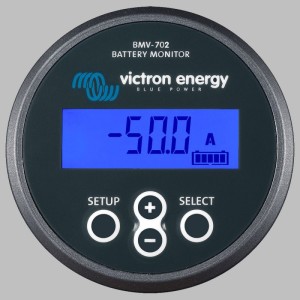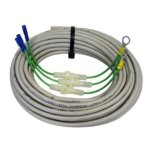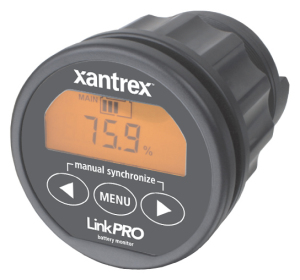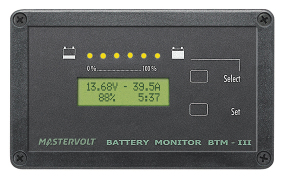Battery Monitors – Victron, Xantrex, and Mastervolt comparison
Since our trip through the San Juan’s in August I’ve been reviewing all the systems onboard and researching energy efficiency options. Having to charge batteries 2-3 times a day was not ideal so I’m looking at ways to both increase the capacity of the house bank and decrease the electrical loads. But before I can really make any concrete plans, I need a way to measure our capacity consumption.

Unfortunately the single analog amp-meter was not cutting it for that, so a more sophisticated digital amp-hour meter was needed.
When looking for a digital battery monitor, obviously there’s the venerable Xantrex Link line of monitors starting with the now discontinued Link 1000 and 2000 to the also discontinued Link 10 and 20, and now the current LinkLite and LinkPro offerings. As I did some my research I came across a few other options including units from Blue Sea Systems, MasterVolt, and Victron Energy. I also was able to put together a list of features that would make a battery monitor both useful and accurate.
Important features for a battery monitor:
- Peukerts exponent – compensates for effects on battery capacity due to different rates of discharge
- Charge efficiency factor (CEF) – compensates for losses related to charging
- Ampere-Hours used – pretty much the primary thing I want to know for planning upgrades
- % state of charge – assuming this is accurate, it would make it easier to know when to charge
- Aux battery voltage – primarily want to be able to do some simple monitoring of the engine start battery
- # of cycles – tracking history of the batteries
- Auto-sync with charge cycles – If I have to push a button to tell the monitor the batteries have been charged, it will never know
- Easy to install – goes without saying
- Reasonable cost – another requirement needing little explanation
So with the above list I pulled together a short list of candidate units (6 models to be exact, that was quickly reduced to 3 models)
Short List:
- Xantrex LinkPro – Very powerful, seems to be sort of the gold standard
- MasterVolt BTM-III – Very powerful, attempts to estimate state of charge for aux banks without a shunt
- Victron Energy BMV-702 – Basically it’s nearly identical totheLinkPro but lacks automatic CEF calculations.

Mastervolt BTM-III While the BMV-702 compensates for CEF like the others, the CEF value is manually set by the user.
Eliminated:
- BlueSea VSM-422 – eliminated because I could find no reference to Peukerts or CEF in their documentation
- Xantrex LinkLite – Looked good at first but does not compensate for CEF and also has no stored history
- Victron Energy BMV-700 – Only supported 1 bank so the start battery could not be monitored. Otherwise it’s nearly identical to the BMV-702
I put together a complete comparison matrix between the 3 top units and I ended up ordering the Victron Energy BMV-702 for a few reasons that I’ll explain. I’ve also highlighted them in the table.
First, cruisers, boaters, and off-grid home owners seem to like the previous version of the Victron BMV-700 Series, the BMV-600 series, quite a bit and the 700 series is really just an enhanced version with more features.


Of course it also ticked all the feature boxes I listed above and then some. The Victron was also the lowest cost unit of the three choices and unlike the other two units, Victron includes the cabling necessary to connect the display to the shunt as well as all the battery voltage sense wires. The shunt is even enhanced with a small circuit board to make connections very quick and easy. This was actually fairly significant because effectively the same cabling that Victron included, costs $100 additional for the LinkPro, making the LinkPro almost double the cost. And even with the cabling kit, there is crimping to be done for the Xantrx unit. I didn’t have to crimp any of the wires for the Victron unit. Finally, the Victron unit has the lowest power consumption of the three options, which matters when the whole point of a battery monitor is to get the most from your battery bank capacity.
On the flip side, as I noted above and highlighted in the table, both the Xantrex and the Mastervolt can apparently automatically calculate the CEF value, something the Victron does not seem able to do. Going even further than the Xantrex and the Victron, Mastervolt’s BTM-III supports voltage monitoring for a third battery bank and also allows a user to enter in rated charger amperage and average current consumption for banks 2 and 3 in order to estimate the state of charge for those banks. I’m aware that, and Mastervolt readily admits this, the state of charge calculation for banks 2 and 3 will not be nearly as accurate as the shunt-monitored primary bank, but it’s interesting that the device attempts to provide any estimate at all.

Since I don’t have experience with any of these units in the field, I don’t know if the automatic CEF calculation in the LinkPro and the BTM-III is worth the extra money. I also don’t know if it’s worth paying far more than double (if you include the cost of wiring) to get the additional information for banks 2 and 3 that the Mastervolt unit provides. For the cost of the Mastervolt or Xantrex units and necessary wiring, I can purchase TWO of the Victron BMV-702s which would provide full shunt-based monitoring of two banks plus voltage monitoring for two more banks (or temperature sensing for the first two banks.)
The Victron unit arrived last week and I spent a couple of hours over the past few days installing it. The included wiring is actually really nice. It’s dead simple to connect, and only one cable runs from the battery box to the display. The only cabling changes I had to make included replacing an end on one of the battery cables to match the terminal size on the new shunt, and add a short (12 inch) battery cable to insert the shunt into the path.
Specs | Xantrex LinkPro www.xantrex.com | Victron BMV-702 www.victronenergy.com | Mastervolt BTM-III www.mastervolt.com |
| Street Price (online) | $266 USD | $207 USD | $368 USD |
| Cabling Kit | $100 Option | Included | Not Included |
| System Voltages | 12V/24V Auto | 12V/24V/48V Auto | 12V/24V Manual |
| # of Shunt Banks | 1 | 1 | 1 |
| # of Aux Banks | 1 | 1 | 2 |
| Included Shunt | 500A | 500A | 500A |
| Max Shunt Size | 10,000A | 10,000A | 1000A |
| Power Consumption | 9mA@12V | 4mA@12V | 14mA@12V |
| Display Size (wxhxd) | 2.54″x2.54″x3.11″ | 2.7″x2.7″x1.2″ | 4.7″x2.6″x2.2″ |
Displayed Data | |||
| Voltage | Bank 1,2 | Bank 1,2 | Bank 1,2,3 |
| Amperage | Bank 1 | Bank 1 | Bank 1 |
| Watts | No | Bank 1 | No |
| Battery Temp | Bank 1 | Bank 1 (disables Bank 2) | No |
| State of Charge % | Bank 1 | Bank 1 | Bank 1,2,3 |
| Ampere-Hours | Bank 1 | Bank 1 | Bank 1 |
| Ampere-Hour Range | 1-999AH | 1-9999AH | 1-2000AH |
| Time-to-Go | Bank 1 | Bank 1 | Bank 1,2,3 |
| Series Midpoint Volts | No | Bank 1 (disables Bank 2) | No |
Configurable Settings | |||
| Charge Efficiency (CEF) | 50-100%, Auto | 50-100%, 95%(def) | 70-96%, 94%(auto) |
| Peukert Exponent | 1.0-1.5, 1.25(def) | 1.0-1.5, 1.25(def) | 1.01-1.5, 1.27(def) |
| Temp Compensation | Yes, with Temp Sensor | Yes, with Temp Sensor | No |
| Battery Capacity (AH) | 1-9990AH | 1-9999AH | 0-9999AH |
Historical Data | |||
| Days Running | No | No | Yes |
| Cycle Count | Yes | Yes | Yes |
| Abuse Cycles | Yes | Yes | Yes |
| Hrs in Deep Discharge | No | No | Yes |
| AH Consumed | Yes | Yes | Yes |
| Average Discharge | Yes | Yes | Yes |
| Deepest Discharge | Yes | Yes | Yes |
| Last Discharge | No | Yes | No |
| Low Voltage Alarms | Yes | Yes | Yes |
| High Voltage Alarms | Yes | Yes | Yes |
| Networking | Yes, RS232 | Yes, VE.Direct/USB | Yes, NMEA/RS232 |
| PC Software | Yes | Yes | Yes |
| Alarm/Relay Output | Yes | Yes | Yes |
*all entries in the table based on manufacturers publicly available online documentation







Pingback: LEDs, An Upgraded House Bank, And a PSA About Proper Charger Cabling | Andersons Abroad
A nice review and comparison, thanks!